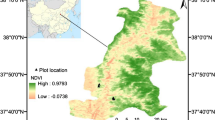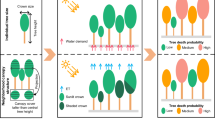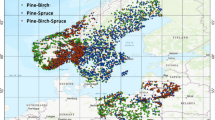Abstract
Tree mortality in response to climate change induced drought has emerged as a global concern. Small changes of tree mortality rates can profoundly affect forest structure, composition, dynamics and ecosystem services such as carbon sequestration. Our analyses of longitudinal data from natural stands (82 plots) in Beijing showed that tree mortality rates have increased significantly over the two decades from 1986 to 2006. In contrast, recruitment rates decreased significantly over this period. The increase in overall mortality rates resulted from an increase in tree deaths dominantly attributed to changes in temperature and precipitation resulting in drier conditions across latitudes, elevations, tree species, and tree sizes. In addition, the results showed that mortality rates of Chinese pine (Pinus tabuliformis) (β 1 = 0.0874) as a result of climate change induce drought were much smaller than oak (Quercus) (β 1 = 0.1583).




Similar content being viewed by others
Explore related subjects
Discover the latest articles and news from researchers in related subjects, suggested using machine learning.References
Adams HD, Claramonte MG, Gafford GAB, Villegas JC, Breshears DD, Zou CB, Troch PA, Huxman TE (2009) Temperature sensitivity of drought-induced tree mortality portends increased regional die-off under global-change-type drought. Proc Natl Acad Sci U S A 106:7063–7066
Affleck DLR (2006) Poisson mixture models for regression analysis of stand-level mortality. Can J For Res 36:2994–3006
Allen CD, Macalady AK, Chenchouni H et al (2010) A global overview of drought and heat-induced tree mortality reveals emerging climate change risks for forests. For Ecol Manag 259:660–684
Arnell NW (2004) Climate change impacts on river flows in Britain: the UKCIP02 scenarios. J Chart Inst Water Environ Manag 18:112–117
Arnone JA III, Verburg PSJ, Johnson DW et al (2008) Prolonged suppression of ecosystem carbon dioxide uptake after an anomalously warm year. Nature 455:383–386
Barber VA, Juday GP, Finney BP (2000) Reduced growth of Alaskan white spruce in the twentieth century from temperature-induced drought stress. Science 405:668–673
Bonan GB (2008) Forests and climate change: forcings, feedbacks, and the climate benefits of forests. Science 320:1444–14449
Bourque CPA, Hassan QK (2008) Projected impacts of climate change on species distribution in the Acadian Forest region of eastern Nova Scotia. For Chron 84:553–557
Breshears DD, Allen CD (2002) The importance of rapid, disturbance-induced losses in carbon management and sequestration. Glob Ecol Biogeogr 11:1–5
Breshears DD, Cobb NS, Rich PM et al (2005) Regional vegetation die-off in response to global-change-type drought. Proc Natl Acad Sci U S A 102:15144–15148
Bytnerowicz A, Michael A, Rocío A (2003) Ozone air pollution in the Sierra Nevada: distribution and effects on forests. Elsevier, Amsterdam
Carnicer J, Coll M, Ninyerola M, Pons X, Sanchez G, Penuelas J (2011) Widespread crown condition decline, food web disruption, and amplified tree mortality with increased climate change-type drought. Proc Natl Acad Sci U S A 108:1474–1478
Chapin FS, Randerson JT, McGuire AD, Foley JA, Field CB (2008) Changing feedbacks in the climate-biosphereront. Ecol Environ 6:313–320
Chen Y, Yang K, He J, Qin J, Shi J, Du J, He Q (2011) Improving land surface temperature modeling for dry land of China. J Geophys Res 116, D20104
Chen T, van der Serf GR, de Jeu RAM, Wang G, Dolman AJ (2013) A global analysis of the impact of drought on net primary productivity. Hydrol Earth Syst Sci Discuss 10:2429–2451
Clark JS, Bell DM, Hersh MH, Nichols L (2011) Climate change vulnerability of forest biodiversity: climate and competition tracking of demographic rates. Glob Chang Biol 17:1834–1849
Feeley KJ, Wright SJ, Supardi NNN, Kassim AR, Davies SJ (2007) Decelerating growth in tropical forest trees. Ecol Lett 10:461–469
Fensham RJ, Fairfax RJ (2007) Drought-related tree death of savanna eucalypts: species susceptibility, soil conditions and root architecture. J Veg Sci 18:71–80
Franklin JF, Shugart HH, Harmon ME (1987a) Tree death as an ecological process. Bioscience 37:550–556
Franklin JF, Shugart HH, Harmon ME (1987b) Tree death as an ecological process. The causes, consequences and variability of tree mortality. Bioscience 37:550–556
Garsed SG, Rutter AJ (1984) The effects of fluctuating concentrations of sulphur dioxide on the growth of Pinus sylvestris L. and Picea sitchensis (Bong) Carr. New Phytol 97:175–195
Gitlin AR, Sthultz CM, Bowker MA et al (2006) Mortality gradients within and among dominant plant populations as barometers of ecosystem change during extreme drought. Conserv Biol 20:1477–1486
Hoerling M, Kumar A (2003) The perfect ocean for drought. Science 299:691–694
Isebrands JG, McDonald EP, Kruger E, Hendrey G, Percy K, Pregitzer K, Karnosky DF, Sober J (2001) Growth responses of Populus tremuloides clones to interacting elevated carbon dioxide and tropospheric ozone. Environ Pollut 115:359–371
Kapeller S, Jexer MJ, Geburek T, Hiebl J, Schueler S (2012) Intraspecific variation in climate response of Norway spruce in the eastern Alpine range: selecting appropriate provenances for future climate. For Ecol Manag 271:46–57
Karnosky DF, Pregitzer KS, Hendrey GR et al (2003) Impacts of interacting CO2 and O3 on trembling aspen: results from the Aspen FACE Experiment. Funct Ecol 17:289–304
Khanduri VP, Sharma CM, Singh SP (2008) The effect of climate change on plant phenology. Environmentalist 28:143–147
Kramer H (1986) Relation between crown parameters and volume increment of Picea abies stands damaged by environmental pollution. Scand J For Res 1:251–263
Li J, Zhang J (1993) Studies on classification models and mechanisms of drought tolerance of chief afforestation species in the northern part of China (I)—the classification of relationships between seedling leaf water potential and soil water content. J Beijing For Univ 15(3):1–11 (in Chinese)
Liu H, Williams AP, Allen CD et al (2013) Rapid warming accelerates tree growth decline in semi-arid forests of Asia. Glob Chang Biol 19:2500–2510
Lwanga JS (2003) Localized tree mortality following the drought of 1999 at Ngogo, Kibale National Park, Uganda. Afr J Ecol 41:194–196
Ma Z, Peng C, Zhu Q, Chen H, Yu G, Li W, Zhou X, Wang W, Zhang W (2012) Regional drought-induced reduction in the biomass carbon sink of Canada’s boreal forests. Proc Natl Acad Sci U S A 109:2423–2427
Maherali H, Pockman WT, Jackson RB (2004) Adaptive variation in the vulnerability of woody plants to xylem cavitation. Ecology 85:2184–2199
Materna J (2002) Impact of air pollution on forests. In: Lomsky B, Materna J, Pfanz H (eds) SO2-pollution and forest decline in the Ore Mountains. Ministry of Agriculture of the Chech Republic. Forestry and Game Management Research Institute, Jiloviste-Strnady, pp 117–138, 342 pp
Mcdowell N, Pockman WT, Allen CD et al (2008) Mechanisms of plant survival and mortality during drought: why do some plants survive while others succumb to drought? New Phytol 178:719–739
Michaelian M, Hogg EH, Hall RJ, Arsenault E (2011) Massive mortality of aspen following severe drought along the southern edge of the Canadian boreal forest. Glob Chang Biol 17:2084–2094
Mueller RC, Scudder CM, Porter ME et al (2005) Differential tree mortality in response to severe drought: evidence for long-term vegetation shifts. J Ecol 93:1085–1093
Nepstad DC, Stickler CM, Soares-Filho B, Merry F (2008) Mortality of large trees and lianas following experimental drought in an amazon forest. Ecology 88:2259–2269
Pacala SW, Canham CD, Saponara J, Silander JA, Kobe RK, Ribbens E (1996) Forest models defined by field measurements: estimation, error analysis and dynamics. Ecol Monogr 66:1–43
Peng C, Ma Z, Lei X, Zhu Q, Chen H, Wang W, Liu S, Li W, Fang X, Zhou X (2011) A drought-induced pervasive increase in tree mortality across Canada’s boreal forests. Nat Clim Chang 1:467–471
Percy KE, Awmack CS, Lindroth RL et al (2002) Altered performance of forest pests under CO2- and O3-enriched atmospheres. Nature 420:403–407
Petras R, Mecko J, Nociar V (2004) The effects of air pollutants on diameter increment of Scots pine and Austrian pine. Ekologia (Bratislava) 23:184–191
Phillips OL, Aragão LE, Lewis SL et al (2009) Drought sensitivity of the Amazon Rainforest. Science 323:1344–1347
Phillips OL, van der Heijden G, Lewis SL et al (2010) Drought-mortality relationships for tropical forests. New Phytol 187:631–646
Ren G, Guo J, Xu M et al (2005) Climate changes of China’s mainland over the past half century. Acta Meteorol Sin 63:942–956 (in Chinese)
Seager R, Ting M, Held I, et al (2012) Model projections of an imminent transition to a more arid climate in southwestern North America. Science 316:1181–1184
Stravinskiene V (2004) Scots pine (Pinus sylvestris L.) radial growth in the vicinity of the nitrogen fertilizers plant “Achema” in Lithuania. Ekologia (Bratislava) 23:438–445
Suarez ML, Ghermandi L, Kitzberger T (2004) Factors predisposing episodic drought-induced tree mortality in Nothofagus-site, climate sensitivity and growth trends. J Ecol 92:954–966
Van Mantgem PJ, Stephenson NL (2007) Apparent climatically induced increase of tree mortality rates in a temperate forest. Ecol Lett 10:909–916
Van Mantgem PJ, Stephenson NL, Byrne JC et al (2009) Widespread increase of tree mortality rates in the western United States. Science 323:521–524
Wang T, Hamann A, Yanchuk A, Nell GAÓ, Aitken SN (2006) Use of response functions in selecting lodgepole pine populations for future climates. Glob Chang Biol 12:2404–2416
Wang W, Zhang W, Cai XJ (2009) Variation of temperature and precipitation in Beijing during latest 50 years. J Arid Meteorol 27:350–353 (in Chinese)
Wolkovich EM, Cook BI, Allen JM et al (2012) Warming experiments underpredict plant phonological responses to climate change. Nature 485:494–497
Wyckoff PH, Clark JS (2002) The relationship between growth and mortality for seven co-occurring tree species in the southern Appalachian Mountains. J Ecol 90:604–615
Xie GD, Li WH, Xiao Y (2010) Forest ecosystem services and their values in Beijing. Chin Geogr Sci 20:51–58
Xu Z, Zhang L, Ruan B (2006) Analysis on the spatiotemporal distribution of precipitation in the Beijing Region. Land Geogr 29:186–192 (in Chinese)
Yang Y, Titus SJ, Huang S (2003) Modeling individual tree mortality for white spruce in Alberta. Ecol Model 163:209–222
Yeh SW, Kug JS, Dewitte B, Kwon MH, Kirtman BP, Jin FF (2009) El Niño in a changing climate. Nature 461:511–514
Zhang J, Li J (1995) Studies on classification models and mechanisms of drought tolerance of major afforestation species in north China—water-hold ability and maintenance of turgor. J Hebei For College 10:188–193 (in Chinese)
Zhang J, Li J, Jiang J (1994) A study on water parameter of plantation in the western mountain area of Beijing, China. J Beijing For Univ 16(1):1–12 (in Chinese)
Zhang S, Chen J, Hua D et al (2010) Research on the assessment of water resource system risk: a case study of Beijing. J Nat Res 25:1855–1863
Zhao M, Running SW (2010) Drought-induced reduction in global terrestrial net primary production from 2000 through 2009. Science 329:940–943
Zheng Z, Zhang X, Gao H, Meng X (2012) An Attribution analysis between the climate warming and extreme temperature indices in Beijing in the past 49 years. J Nat Res 28:277–282
Acknowledgments
We are grateful to the editor and two anonymous reviewers for their valuable suggestions and comments on the manuscript. Funding for the study was provided by the Ministry of Science and Technology (MOST), National Natural Science Foundation of China (NSFC) (No. 2005DIB5JI42, No. 2012AA12A306 and No. 31170588), and Collaborative innovation plan of Jiangsu higher education. We are also grateful to the Inventory Institute of Beijing Forestry for its data.
Author information
Authors and Affiliations
Corresponding author
Electronic supplementary material
Below is the link to the electronic supplementary material.
Table S1
(DOC 240 kb)
Rights and permissions
About this article
Cite this article
Zhang, X., Lei, Y., Pang, Y. et al. Tree mortality in response to climate change induced drought across Beijing, China. Climatic Change 124, 179–190 (2014). https://doi.org/10.1007/s10584-014-1089-0
Received:
Accepted:
Published:
Issue Date:
DOI: https://doi.org/10.1007/s10584-014-1089-0




